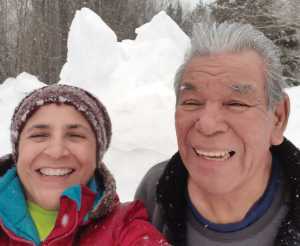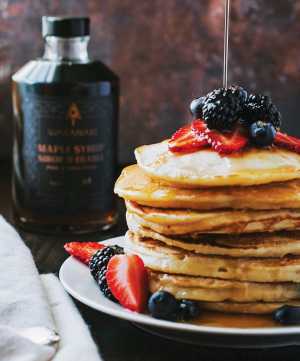Is there anything perceived as more Canadian than maple syrup? The red leaf that grows on the maple tree is, after all, the symbol on the Canadian flag. While the lands that the country sits on do produce 85 per cent of the world’s maple syrup, the delicious topper of many a pancake and waffle is, first and foremost, a First Nations food.
There are many different stories among various Indigenous Peoples of how maple syrup came to be. For Mohawks, maple trees were a gift from the Creator, that, when tapped, would flow with pure syrup. Legend has it that the Creator returned to find the longhouses empty, children no longer playing, and everyone lying beside a tree with the syrup flowing directly into their mouth. The Creator informed them that they had abused the gift and would now have to tap it and boil it for hours.
Maple syrup is also a way of giving thanks, which the Haudenosaunee do to this day. In fact, it’s so central that a maple ceremony is part of the Midwinter ceremonies. The Anishinaabe celebrate the third moon, known as Sugar Moon, named for the period when the maple sap starts to run. That moon alerts people that it’s time to harvest the sap and also serves as a reminder that it’s time to balance life, just as sap balances their blood sugar levels. It is also celebrated as the new year.
Historical records of early visitors to North America show that as early as the 1500s, the Mi’qmaw, Haudenosaunee and Anishinaabe Peoples were collecting and distilling sap, and were masters of it long before Europeans came along. Maple syrup sellers, Deborah Aaron and Isaac Day both come from First Nations communities — Aaron from Six Nations of the Grand River and Day from Serpent River First Nations — and have childhood memories rooted in collecting sap.
“My dad remembered going with a horse and wagon collecting the syrup, back in bush,” says Aaron. “Before he passed on, we had around 50 trees and we'd tap a few of those and have a family celebration of tapping and being outside.”
Day’s recollections go back to when he was six or seven years old. Raised by his grandfather, he recalls living on the land, fishing and snaring rabbits, as well as heading out to tap the trees at sugar time.
“The thing that brought us out there was what we called ziinzibaakwad. It means maple sugar candy in Ojibway, and it was like a medicine because it brought delight,” says Day. “It made you smile and feel good and all the work that it took was connected to nature.”
Maple trees are tapped by drilling holes into trunks and collecting sap
Several different families, each of them with kids around his age, would camp out to collect the syrup, and Day says he’d fall asleep to the soothing sound of Elders talking and laughing by the fire. In the morning, he’d wake up to the movement of people getting ready for the next gathering of buckets full of syrup. Armed only with a cast iron pan, sticks and birch bark buckets, they’d take their sap and boil it from the afternoon to overnight, with people sleeping in shifts to oversee the boiling.
“To me, it was a ceremony. When the trees did their ceremony, we participated,” says Day. “What they were doing [was] giving what they were sharing. It was the medicine that they were giving to the people to bring them together, to keep them together, to help you grow together and bring the foundation for the youth to be good Elders, and strong people.”
“I get emotional thinking about all the stuff that we left behind — it was magic,” he says now, on a video chat beside his wife.
Together the husband and wife duo co-own Giizhigat Maple Products, one of only a few Indigenous commercial sellers of maple syrup. Operating from their farm on St. Joseph Island in Northern Ontario, near Sault Saint Marie, the two sell syrup, maple butter, maple candies and maple sugar, and try to recapture the magic of those times with family. Launched in 2012, the idea behind the company was sparked by a friend pointing out the potential of tapping the maple trees on the farm and harvesting maple for extra income.
I get emotional thinking about the stuff we left behind — it’s magic
“The maple has always been a sideline to trying to [build] a healing and teaching lodge,” says Aaron. People come to the lodge to learn from her husband, who is an Elder and Knowledge Keeper.
With 3,000 taps, the couple is a two-person operation, with help from their two adult sons who do the line work, boil the syrup and help their father cut the wood. There aren’t any birch bark buckets being used at Giizhigat now, says Day. It’s all tubes and industrial tanks, and heavy-duty evaporators and sugaring equipment. Aaron adds that they still incorporate teachings and ceremony into their sap collection, like wrapping up some of the trees in seven different coloured fabrics — each colour a reminder of love, honesty, kindness, respect, humility and strength — to give thanks for the syrup they received.
Aaron often tries to educate people on maple syrup’s origins. Before the pandemic, at events and markets, she would hand out an information sheet that spoke about syrup being an Indigenous food and its origin story in the Mohawk legend, where the Creator gave the sweet water to the people to nourish them after a long winter.
“People associate it as a Canadian food, and it's an important fact that people need to be reminded of,” she says. “Tourists that come to Canada love picking up something Indigenous. And I’d tell them they’re taking home something that's from this country’s original people.”
For Jolene Laskey, the seed was planted for Wabanaki Maple over 20 years ago. Laskey’s sister had been tapping and harvesting maple syrup as a hobby at her and her husband’s hobby sugar bush. It took several years after that to even realize that the harvesting they were doing was historically Indigenous.
Wabanaki Maple is a Tobique First Nation-based company in New Brunswick, owned and operated by Laskey. It offers handcrafted, small-batch, barrel-aged maple syrup in flavours like toasted oak, whisky and bourbon, and recipes on its website include maple-glazed pork belly and maple bourbon seafood glaze. They also sell maple sugar and are looking to expand their facility to accommodate more capacity and volume.
“One of my favorite things is to get out into the bush in the spring and put on the snowshoes and do it old school — by the buckets that you gotta lug,” she says. That old school method used by her sister became something she loved to do, and when looking for a business idea, she came to the realization that she could combine something she loved with a way to connect even further with her Wolastoqiyik heritage.
While the maple syrup for Wabanaki is currently outsourced, Laskey says that she’s hoping that by 2022, they’ll be producing their own syrup and will include the tapping as a visitor experience. It will also serve as a continuation of the education that Laskey provides when she teaches people about the original heritage of maple syrup.
“We’ve been making some waves with people, helping them to understand that maple syrup is and always has been one of our traditional foods,” says Laskey. “It's always been there for us, has been collected by us, and shared by us with early settlers and Europeans.”
Maple syrup has always been one of our traditional foods
That connection to Indigenous people is incorporated throughout the company’s website, branding and social media, and at in-person events, like farmer’s markets and trade shows. Laskey says that many newcomers to Wabanaki Maple come away with a new way of looking at maple syrup.
Decolonizing the idea of maple syrup and revitalizing its Indigenous origins can’t simply be left up to small companies like Giizhigat and Wabanaki. The onus is on major maple syrup companies to turn the spotlight onto its history and educate its consumers, maybe in a maple syrup twist on the Got Milk? ads from way back when.
Wabanaki and Giizhigat are both proudly Indigenous, but they don’t have a lot of competition at the moment. Neither of them could suggest other Indigenous-owned companies selling commercially.
Aaron says the reason is largely because it’s an expensive endeavour. Some people set up a few taps and sell locally, but many don’t bother because it’s a high investment to get all of the equipment. She also notes that to do it commercially, you need a lot of maple trees.
There are many road bumps for these small syrup-centred businesses. For Giizhigat, the local markets, powwows and events they’d normally be selling their wares at closed their physical spaces during COVID.
As for COVID, despite concerns that the supply chain would be affected for Wabanaki Maple, Laskey says it wasn’t their main worry. The problem instead lies in funding.
“At this point, our biggest challenge has been securing working capital because we're located on First Nation,” she says. “I've had to bootstrap for the past three years, using my own line of credit, so the cash flow has been challenging to manage at times, but we're doing it. I know I'm not alone in this situation, there are so many Indigenous entrepreneurs that are facing that barrier, trying to get the security or loans.”
Wabanaki Maple is currently sold across the Tobique community, as well as retailers across Canada (Sanagan’s Meat Locker in Toronto stocks the versatile syrup), while Giizhigat sells online nationwide. With each product sold from these Indigenous-owned companies, the Canadian association to maple syrup is cracked just a tiny, sweet bit.



